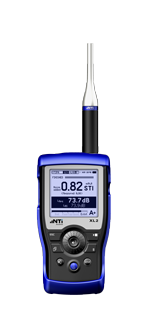The STIPA test signal is a modulated sinusoidal Pink Noise in the octave band range from 125 Hz to 8 kHz. The modulation and range mimics a person’s voice with its varying intensity over time. Nevertheless, the STIPA test signal sounds nothing like a human voice; it is a modulated Pink Noise.
Rooms without Audio Systems
In locations such as classrooms, where no PA system is installed, the STIPA test signal should be reproduced by an appropriate loudspeaker at the position and with the typical sound pressure level of the speaker (the teacher). Requirements for such a loudspeaker are defined in the IEC 60268-16 standard, which states that the typical level of a human talker corresponds to 60 dBA @ 1 m distance.
Furthermore, the ITU-T P.51 standard defines an appropriate loudspeaker to be one where the radiation characteristic corresponds broadly to that of a human mouth.
The Talkbox acoustic signal generator with built-in loudspeaker is designed for this application.
Audio Systems with Voice Microphones
In locations where the announcement is picked up by a voice microphone, and then broadcast through a PA system, the STIPA test signal must be replayed acoustically into the microphone. For this purpose, an appropriate loudspeaker is required to present the standardized voice-like acoustic signal, simulating a human talker according to IEC 60268-16, at the correct levels. This setup considers the entire signal path for an accurate speech intelligibility measurement, including all effects of the operator's microphone and environment.
Again, the Talkbox acoustic signal generator + loudspeaker is designed for this application.
Audio Systems without Voice Microphones
If the location comprises of a PA system including a hard drive to replay pre-recorded announcements, the STIPA test signal must be injected electronically from an external sound generator. This generator must be able to continuously play the STIPA test signal at selectable line levels.
The MR-PRO audio signal generator is designed for this application.

STI Measurement
For the evaluation of the acoustic STIPA test signal, you need an STI analyzer. It is recommended that this device be hand-held and portable. The reason is that, for the complete STI assessment of a room, you typically have to execute several measurements at different positions, each of them lasting 15 seconds.
After averaging this data, and optionally applying ambient noise correction, it will be convenient for you to check the results immediately. This allows you to implement changes to the acoustics of the room straight away, if necessary, in order to improve the speech intelligibility, and measure again.
The XL3 and XL2 Analyzers are both capable of STIPA measurements.